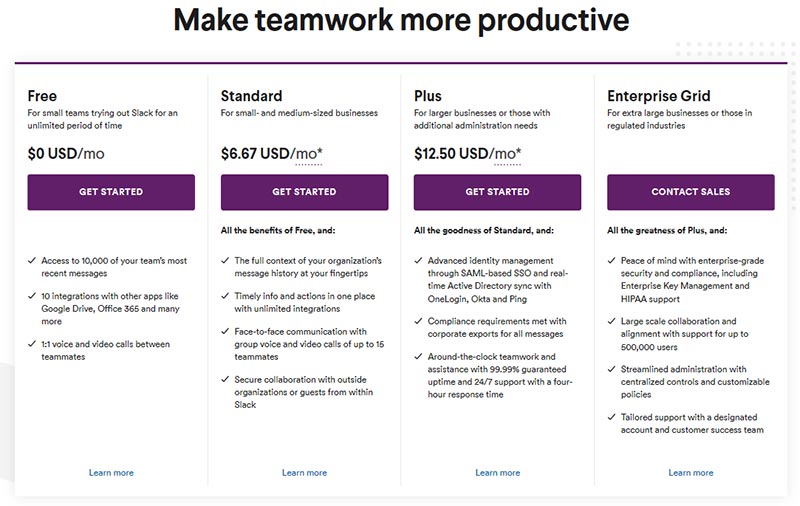To publish or not to publish your pricing? When it comes to software as a service (SaaS) products, there seems to be two very distinct sides regarding enterprise-level pricing visibility.
Many businesses choose not to publish their price. Instead, they leave it blank or qualify the price with a ‘contact us’ directive.
Instant messaging platform Slack, for example, is one SaaS business that holds back on its enterprise pricing.

Alternately, Mattermost—a popular alternative to Slack—displays its enterprise-level pricing on a ‘per user’ basis.

Why is it some businesses opt not to publish an enterprise-level price, while others choose to be completely transparent and put everything on the table at every level?
Determining your SaaS business’s target customer
Of course, not all customers are created equal. There are different employee counts, different security needs, different user needs, etc. And as SaaS businesses provide products that can be tailored to the specific needs of their customers, it stands to reason they should also have customized pricing options.
The short answer to the publish/unpublished conundrum may lay in your ideal customer. Are you hunting elephants, or is your offering more applicable to mice?
In other words, as a SaaS business, is your ideal customer just starting out or is it a large, well-established enterprise business?
The size of your ideal customer will indicate what kind of SaaS pricing and features you’ll need to offer.
A low-touch or self-service plan is one that will be more affordable but will give customers limited support. Their go-to for help will likely be your Frequently Asked Questions web page, with the option to email a help desk with questions.
This provides access to smaller customers, while also ensuring this customer type doesn’t over burden the resources in your customer service department.
However, this type of customer is more likely to be discouraged by a ‘contact us’ feature and is likely to pass you by to seek out a competitor with pricing clearly indicated on its website.
On the other hand, a high-touch enterprise plan will attract larger, more established businesses. These customers are willing to pay a steeper price for more users and more features, such as immediate access to ‘premium’ customer support through different channels, including phone, email, or a chat box.
The dual sides of the ‘contact us’ debate
If your business has decided to put resources into attracting enterprise-level customers, there’s still the question of publishing your prices as part of your SaaS pricing strategy. What’s the better sales practice?
Here’s how several leaders feel about enterprise SaaS pricing.
1. Transparent pricing
BrandMentions is a tool businesses can use to monitor social media and uncover what’s being said online about their brand and their competition. According to the company’s findings, “close to 80% of all websites displayed the highest package cost as ‘Contact Us’, rather than provide an actual figure.”
Some influencers insist publishing prices is the only way to go. Business trends are moving toward transparency, meaning the best way to demonstrate your trustworthiness to customers is by letting them see valuable components, including pricing.
Vijay Sundaram voiced his concerns about not publishing prices in a diginomica.com article.
“Price is often the first thing a customer will look at when weighing their software options,” he wrote. “Customers who see plans listed as ‘call for pricing’ may think, ‘If I have to ask, I probably can’t afford it.’ This isn’t a model for customer growth…”
Transparency is integral, Patrick Moorehead agreed in an AiThority article. Showing your prices inspires consumer confidence, he explained.
It’s a good rule to be as explicit as you can with what things cost and how you got to those prices.”
The drive toward transparency inspired one company, in particular. Capiche CEO Austin Smith recently closed on a $450,000 angel funding round to facilitate better pricing transparency for software companies. The business is in the process of compiling ‘pricing stories’.
Smith’s hope is that by sharing information on business pricing, the industry will be encouraged to provide more concise prices.
But others argue publishing prices isn’t always beneficial, and they promote a more bespoke pricing strategy.
2. Tailored SaaS pricing strategy
On the surface, one reason businesses choose not to publish prices is because they don’t want their competitors to get wind of that information.
However, there are even more compelling reasons a business may opt not to publish its enterprise pricing.
SaaS pricing isn’t a one-size-fits-all venture. Businesses that offer tiered pricing already ascribe to this reasoning.
Let’s say a business offers three levels, with a published price at the top level for, say, 25+ users. Obviously, there’s a significant difference between your resources supporting 26 users, versus 100 users.
It’s more than just the number of users, though. Matrix Partners’ David Skok points out pricing strategies also need to consider the ‘depth of usage’. In other words, how are your customers going to use your software? How much storage will be needed to support an enterprise customer?
Furthermore, what level of complexity will be involved with integrating your product with the customer’s current business infrastructure, and will they require additional customized features and functionality?
Do you really want to be tied to a published price? Alexander Buchberger, Managing Director at Senovo, likens publishing prices to an anchor.
“Each industry and each functional department might have different pricing points and budgets,” he wrote in a Medium article. “Either you sell your product for too little money for accounts with larger budgets or smaller accounts drop out of the lead generation process as the pricing on your website highly exceeds their budget.”
Sometimes it’s worth having a discussion first to see how your SaaS business can best suit the needs of prospective customers before putting a price tag on it.
How does the enterprise sales funnel work with SaaS pricing?
If you do opt for unpublished pricing, the work is just beginning when a prospective customer contacts you.
First, make sure prospects have multiple options to contact your business. Phone calls should go to sales team members who can quickly and easily source information and assistance from sales engineers or sales architects. Team members taking initial calls should be able to field questions about your product as well as help close the sale.
Some prospective clients may not want to take the time to call, so your ‘contact us for pricing’ link should go to a page with a contact form. Experts say the form should ask few questions as well as include a ‘comments’ field so prospects can elaborate on their needs.
Next, if you can, give them access to a ‘freemium’ version of your product. This step provides limited functionality, but lets them see how your software can address those needs.
Once the sales team has conducted initial fit and requirement discovery, a product demo is ideal for walking the prospect through the product and its features with a sales engineer or solutions architect on your team.
This puts another live person into play who can point out features and functionality that might be otherwise overlooked. This live demonstration and interaction with the prospect not only enables immediate response to any questions but is also an opportunity for your business to drive home the value of your products and features.
The information gathered in the sales funnel generates the critical information your business needs to tailor the best price for that prospect.
Is it in your SaaS business’s best interest to provide absolute pricing transparency? Or does publishing your prices open your business up to undervaluing its products and services?
As any SaaS veteran knows, pricing your product and developing the most effective long-term strategy takes effort.
But veterans also know that no matter what strategy is decided on today, circumstances can change in a month or a year, so what works now should be reconsidered regularly.






